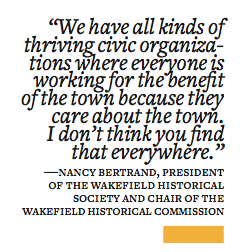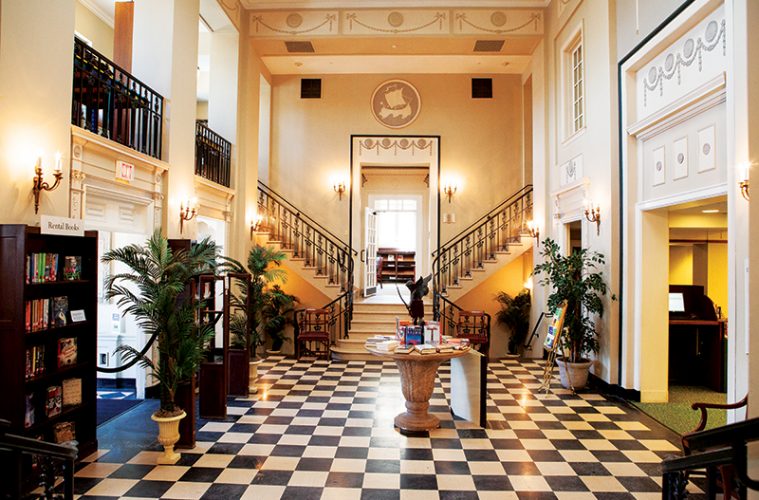Wakefield has a community and civic spirit.
There are two characteristics that make Wakefield the town that it is. First, and most obvious, is Lake Quannapowitt—the large natural lake that dominates the town’s landscape and attracts visitors from towns across the region.
The other characteristic might not be as evident, but it’s one that makes Wakefield’s residents love their town, stay there for years, and come back after they’ve left. That characteristic is civic spirit.
“There’s a large percentage of people who grew up in Wakefield who have stayed in Wakefield,” says Joseph Harrington, vice president of the Wakefield Center Neighborhood Association, and he’s among them. He returned after college and settled here with his wife because he wanted to live in a town with the strong sense of community that he’d always known in Wakefield.
“I really didn’t find one that had the same feel as I remembered growing up,” Harrington says.
Civic pride and involvement is a hallmark of living in Wakefield, and the people who call Wakefield home are often unusually involved in making their town a place where they love to live and raise their families. Groups do everything from running events on the common to organizing book clubs at the library, to main- taining plantings along the lake to spearheading local theater programs. Among the most active groups is the Wakefield Center Neighborhood Association.
“The mission is to improve or maintain areas surrounding the common and thedowntown area,” Harrington says. “There are things that would possibly fall through the cracks for the town to do.”
For instance, the association has twice built a playground on the lower common and put benches on both the upper and lower common. It maintains the Rockery fountain that the group restored, as well as the surrounding landscape. It also runsannual festivals such as the Christmas tree lighting on the first weekend in December; an egg hunt in the spring; and the Festival by the Lake in June, which hosts more than 100 crafters from around New England and includes kids’ activities, food vendors, and live entertainment.
The spirit of giving back has been part of Wakefield’s history for more than a century, says Nancy Bertrand, president of the Wakefield Historical Society and chair of the Wakefield Historical Commission. Cyrus Wakefield, the 19th-century industrialist and maker of rattan furniture for whom the town is named, actually gifted Wakefield with its town hall and helped erect a Civil War memorial, among other services to the town.
“Once he moved here, he really set out to improve the town,” Bertrand says.
Wakefield began its life as the original settlement of Reading, before splitting into its own town in 1812. It called itself “South Reading” for several decades and changed its name to Wakefield in 1868 in honor of the man who’d given so much to the town. And Cyrus Wakefield’s philanthropic spirit clearly lives on there.
“I think one of the great things about Wakefield is how strongly everyone feels about the town, and everyone gets involved,” Bertrand says. “We have all kinds of thriving civic organizations where everyone is working for the benefit of the town because they care about the town. I don’t think you find that everywhere.”
Modern Wakefield has a wide downtown, giving it an old-fashioned, made-for-walking feel.
 |
“I can walk down the street and go to the pharmacy. There’s an ice cream store, there’s a hair salon, there’s a nail salon,” says Denise DiTonno, Wakefield resident and owner of Denise’s Daycare. “I don’t have to get into my car if I really don’t want to. A lot of times I do walk.”
Although Wakefield is immensely walkable and feels like a small town, it’s also a hub for much of the region. With its commuter rail stop and location just 12.5 miles rom Boston, Wakefield allows people to live in a close-knit suburb without a long commute into the city.
“It’s really ideally located as far as roads getting into Boston and going to the North Shore,” says Bertrand. “It’s almost at the junction of Route 93 and Route 128, so it’s great.”
It’s that combination of proximity to Boston, natural beauty, and civic involvement that makes it so hard for people to leave Wakefield and so easy to put down deep roots here.
“It’s really a pretty downtown. I’m prejudiced for it,” Bertrand says. “It’s a hometown.”
THE DETAILS
Date of settlement: 1638
Date of incorporation: 1812
Area: 7.9 square miles
Population: 24,932
ZIP code: 01880
Median household income: $85,011
Public schools: Dolbeare Elementary, Greenwood Elementary, Walton Elementary, Woodville Elementary, Galvin Middle, Wakefield High
Notable residents: Former Senator Scott Brown; 2012 Olympic gold medalist in judo Kayla Harrison; journalist, author, and bon vivant Lucius Morris Beebe; 19th-century industrialist and town namesake Cyrus Wakefield; playwright, screenwriter, and father to Adam Horovitz of the Beastie Boys, Israel Horovitz; former Massachusetts Governor John Anthony Volpe; former NFL player Dave Lapham; Olympian and former NHL player Mark Kumpel; retired United States general for whom the Galvin Middle School is named, John Galvin

